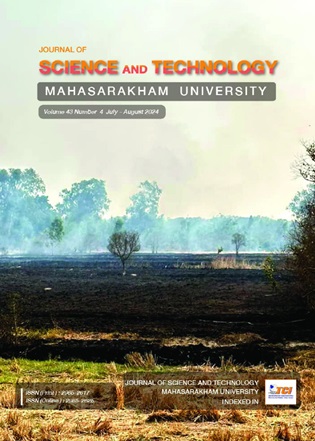Morphological diversity of Kratom (Mitragyna speciosa (Korth) Havil) at population level in Southern Thailand
Main Article Content
Abstract
The objective of this research was to study the diversity of kratom subpopulation in the Southern Thailand using morphological characteristics for classification. Study on kratom specimens in 9 provinces in the area of Southern Thailand: Surat Thani, Nakhon Si Thammarat, Trang, Phatthalung, Krabi, Phang Nga, Chumphon, Prachuap Khiri Khan and Ranong. Record of ecosystem and morphological characteristics. Data were analyzed and a dendrogram using the UPGMA technique. It was found that kratom can be divided into 2 large groups: 1) Group of green petiole includes green, yellow-green and green-yellow colors 2) group of red petiole includes red, red-orange, pink-orange colors. Leaf shape can be classified into 3 types: lanceolate, obvate and obovate. Leaf base can be classified into 3 types: cuneate, obtuse and cordate. Leaf apex can be classified into 2 types: cuminate and cuspidate. Leaf margin can be classified into 2 types: entire and dentate. Stipule color can be classified into 3 groups: green and yellow-green group, orange-pink and pink-orange group and red-orange and red group. Therefore, it can be indicated that the Southern Thailand has a wide variety of kratom population with morphological differences.
Article Details
References
สำนักงานหอพรรณไม้. (2559). คู่มือจำแนกพรรณไม้. สำนักวิจัยการอนุรักษ์ป่าไม้และพันธุ์พืช. กรมอุทยานแห่งชาติ สัตว์ป่า และพันธุ์พืช. ห้างหุ้นส่วนจำกัด สิทธิโชค พริ้นติ้ง. กรุงเทพฯ: 240 หน้า.
ธนัช นาคะพันธ์. (2559). การศึกษาการใช้ประโยชน์จากกระท่อม ในการรักษาโรคของหมอพื้นบ้านภาคใต้. วารสารการแพทย์แผนไทยและการแพทย์ทางเลือก, 14(3), 274-285.
Asanakornchai, S., Saingam, D., Siriwong, A., & Wungsintaweekul, J. (2015). Conclusion of kratom plant. Charansanitwong Publisher.
Caliskan, M.E., Sogut, T., Boydak, E. & Arioglu, H. (2007). Genotype x environment interaction and stability analysis of sweetpotato (Ipomoea batatas) genotypes, New Zealand. Journal of Crop and Horticultural Science, 35(1), 87-99, https://10.1080/01140670709510172
Chittrakarn, S., Sawangjaroen, K., Prasettho, S., Janchawee, B. & Keawpradub, N. (2008). Inhibitory effects of kratom leaf extract (Mitragyna speciosa Korth.) on the rat gastrointestinal tract. J. Ethnopharmacol., 116(1), 173-178.
Chittrakarn, S., Radenahmad, N., Kaewsara, S., Udomuksorn, W., Keawpradub, N., & Phukpattaranont, P. (2018). Gastroprotective effects of methanolic extract of kratom leaves on gastric ulcer and reflux esophagitis in rats. Songklanakarin J. Sci. Technol., 40(2), 258-273.
Collins, W.W., Wilson, L.G., Arrendell, S., & Dickey, L.F. (1987). Genotype × environment Interactions in sweet potato yield and quality factors. Journal of the American Society for Horticultural Science, 112(3), 579-583. https://doi.org/10.21273/ JASHS.112.3.579
Hemby, S.E., McIntosh, S., Leon, F., Cutler, S.J., & McCurdy, C.R. (2019). Abuse liability and therapeutic potential of the Mitragyna speciosa (kratom) alkaloids mitragynine and 7-hydroxymitragynine. Addiction Biology, 24(5), 874–885. https://doi.org/10.1111/adb.12639
Houghton, P.J., Latiff, A., & Said, I. M. (1991). Alkaloids from Mitragyna speciosa. Phytochemistry, 30 (1), 347–350. https://doi.org/10.1016/0031-9422(91)84152-I
Kumarnsit, E., Keawpradub, N. & Nuankaew, W. (2006). Acute and long-term effects of alkaloid extract of Mitragyna speciosa on food and water intake and body weight in rats. Fitoterapia, 77, 339-345.
Meepong, R., & Sooksawate, T. (2019). Mitragynine reduced morphine-induced conditioned place preference and withdrawal in rodents. Thai Journal of Pharmaceutical Sciences (TJPS), 43(1), 21-29.
Rohlf, F.J. (1997). NTSYS-Pc. Numerical taxonomy and multivariate analysis system version 2.2e. Exeter Software.
Sneath, P.H. & Sokal, R.R. (1973). Numerical taxonomy: The principles and practice of numerical classification. W. H. Freeman.


